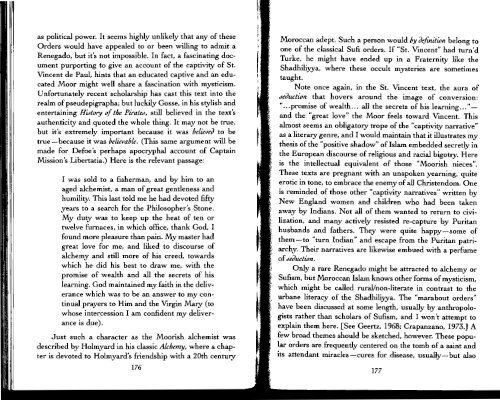Create successful ePaper yourself
Turn your PDF publications into a flip-book with our unique Google optimized e-Paper software.
as political power. It seems highly unlikely that any of these<br />
Orders would have appealed to or been willing to admit a<br />
Renegado, but it's not impossible. In fact, a fascinating document<br />
purporting to give an account of the captivity of St.<br />
Vincent de Paul, hints that an educated captive and an educated<br />
Moor might well share a fascination with mysticism.<br />
Unfortunately recent scholarship has cast this text into the<br />
realm ofpseudepigrapha; but luckily Gosse, in his stylish and<br />
entertaining HiJtory 0/ the Piratu, still believed in the text's<br />
authenticity and quoted the whole thing. It may not be true,<br />
but it's extremely important because it was beliew:iJ to be<br />
true - because it was belie"a.6le. (This same argument will be<br />
made for Defoe's perhaps apocryphal account of Captain<br />
Mission's Libertatia.) Here is the relevant passage:<br />
I was sold to a fisherman, and by him to an<br />
aged alchemist, a man of great gentleness and<br />
humility. This last told me he had devoted fifty<br />
years to a search for the Philosopher's Stone.<br />
My duty was to keep up the heat of ten or<br />
twelve furnaces. in which office, thank God, I<br />
found more pleasure than pain. My master had<br />
great love for me, and liked to discourse of<br />
alchemy and still more of his creed. towards<br />
which he did his best to draw me. with the<br />
promise of wealth and all the secrets of his<br />
learning. God maintained my faith in the deliverance<br />
which was to be an answer to my continual<br />
prayers to Him and the Virgin Mary (to<br />
whose intercession I am confident my deliverance<br />
is due).<br />
Just such a character as the Moorish alchemist was<br />
described by Holmyard in his classic Alchemy, where a chapter<br />
is devoted to Holmyard's friendship with a 20th century<br />
176<br />
Moroccan adept. Such a person would by definition belong to<br />
one of the classical Sufi orders. If "St. Vincent" had turn'd<br />
Turke, he might have ended up in a Fraternity like the<br />
Shadhiliyya, where these occult mysteries are sometimes<br />
taught.<br />
Note once again, in the St. Vincent text, the aura of<br />
JeiJuctwn that hovers around the image of conversion:<br />
..... promise of wealth... all the secrets of his learning..."<br />
and the "great love" the Moor feels toward Vincent. This<br />
almost seems an obligatory trope ofthe"captivity narrative"<br />
as a literary genre. and I would maintain that it illustrates my<br />
thesis ofthe "positive shadow" of Islam embedded secretly in<br />
the European discourse of religious and racial bigotry. Here<br />
is the intellectual equivalent of those "Moorish nieces".<br />
These texts are pregnant with an unspoken yearning, quite<br />
erotic in tone. to embrace the enemy of all Christendom. One<br />
is reminded of those other "captivity narratives" written by<br />
New England women and children who had been taken<br />
away by Indians. Not all of them wanted to return to civilization,<br />
and many actively resisted re-capture by Puritan<br />
husbands and fathers. They were quite happy-some of<br />
them-to "turn Indian" and escape from the Puritan patriarchy.<br />
Their narratives are likewise embued with a perfume<br />
of.1eductwn.<br />
Only a rare Renegado might be attracted to alchemy or<br />
Sufism, but Moroccan Islam knows other forms ofmysticism,<br />
which might be called rural/non-literate in contrast to the<br />
urbane literacy of the Shadhiliyya. The "marabout orders"<br />
have been discussed at some length, usually by anthropologists<br />
rather than scholars of Sufism, and I won't attempt to<br />
explain them here. [See Geertz. 1968; Crapanzano, 1973.] A<br />
few broad themes should be sketched, however. These popular<br />
orders are frequently centered on the tomb of a saint and<br />
its attendant miracles-cures for disease, usually-but also<br />
177


